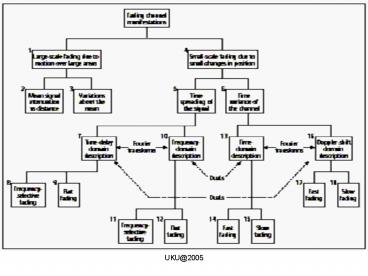Small Scale Multipath Propagation - PowerPoint PPT Presentation
1 / 25
Title:
Small Scale Multipath Propagation
Description:
Fading is purely a spatial phenomenon (occurs only when the mobile receiver moves) ... Causes the total signal at receiver to fade or distort. Speed of mobile ... – PowerPoint PPT presentation
Number of Views:1518
Avg rating:3.0/5.0
Title: Small Scale Multipath Propagation
1
(No Transcript)
2
Small Scale Multipath Propagation
- Effects of multipath
- Rapid changes in the signal strength
- Over small travel distances, or
- Over small time intervals
- Random frequency modulation due to varying
Doppler shifts on different multiples signals - Time dispersion (echoes) caused by multipath
propagation delays - Multipath occurs because of
- Reflections
- Scattering
3
Multipath
- At a receiver point
- Radio waves generated from the same transmitted
signal may come - from different directions
- with different propagation delays
- with (possibly) different amplitudes (random)
- with (possibly) different phases (random)
- with different angles of arrival (random).
- These multipath components combine vectorially at
the receiver antenna and cause the total signal - to fade
- to distort
4
Multipath Components
Radio Signals Arriving from different directions
to receiver
Component 1
Component 2
Component N
Receiver may be stationary or mobile.
5
Mobility
- Other Objects in the radio channels may be mobile
or stationary - If other objects are stationary
- Motion is only due to mobile
- Fading is purely a spatial phenomenon (occurs
only when the mobile receiver moves) - The spatial variations as the mobile moves will
be perceived as temporal variations - Dt Dd/v
- Fading may cause disruptions in the communication
6
Factors Influencing Small Scale Fading
- Multipath propagation
- Presence of reflecting objects and scatterers
cause multiple versions of the signal to arrive
at the receiver - With different amplitudes and time delays
- Causes the total signal at receiver to fade or
distort - Speed of mobile
- Cause Doppler shift at each multipath component
- Causes random frequency modulation
- Speed of surrounding objects
- Causes time-varying Doppler shift on the
multipath components
7
Factors Influencing Small Scale Fading
- Transmission bandwidth of the channel
- The transmitted radio signal bandwidth and
bandwidth of the multipath channel affect the
received signal properties - If amplitude fluctuates of not
- If the signal is distorted or not
8
Doppler Effect
- Whe a transmitter or receiver is moving, the
frequency of the received signal changes, i.e. It
is different than the frequency of transmissin.
This is called Doppler Effect. - The change in frequency is called Doppler Shift.
- It depends on
- The relative velocity of the receiver with
respect to transmitter - The frequenct (or wavelenth) of transmission
- The direction of traveling with respect to the
direction of the arriving signal.
9
Doppler Shift Transmitter is moving
The frequency of the signalthat is received in
front of the transmitter will be bigger
The frequency of the signalthat is received
behind the transmitter will be smaller
10
Doppler Shift Recever is moving
S
Dl
X
Y
q
d
v
A mobile receiver is traveling from point X to
point Y
11
Doppler Shift
- The Dopper shift is positive
- If the mobile is moving toward the direction of
arrival of the wave - The Doppler shift is negative
- If the mobile is moving away from the direction
of arrival of the wave.
12
Impulse Response Model of a Multipath Channel
- The wireless channel charcteristics can be
expressed by impulse response function - The channel is time varying channel when the
receiver is moving. - Lets assume first that time variation due
strictly to the receiver motion (t d/v) - Since at any distance d vt, the received power
will ve combination of different incoming
signals, the channel charactesitics or the
impulse response funcion depends on the distance
d between trandmitter and receiver
13
(No Transcript)
14
(No Transcript)
15
(No Transcript)
16
(No Transcript)
17
(No Transcript)
18
(No Transcript)
19
(No Transcript)
20
(No Transcript)
21
(No Transcript)
22
(No Transcript)
23
(No Transcript)
24
(No Transcript)
25
(No Transcript)































